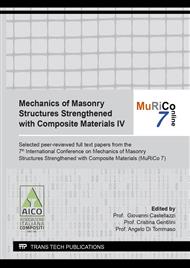p.115
p.123
p.130
p.136
p.147
p.155
p.163
p.172
p.180
A Design-Oriented Stress-Strain Constitutive Model for Clay-Brick Masonry Columns Confined by FRP
Abstract:
Experimental tests proved that the external confinement of masonry columns through Fiber-Reinforced Polymers (FRP) induces increment of axial strength and ductility. Contrary to FRP-confined concrete, for which reliable unified theoretical stress-strain models are available in literature or included in the codes, to develop easy-to-use constitutive models valid for whatever type masonry represents a difficult challenge. In fact, several parameters influence the axial stress-strain response of confined masonry, such as the relative mortar-to-stones strength, masonry texture, deformation capacity of materials, type of reinforcement ad its arrangement. In this paper, a design-oriented stress-strain model devoted to describe the compressive behavior of FRP-confined clay-brick masonry columns is presented. The main scope of the research consists of providing an easy-to-use predictive model, applicable both in the research field and design practice. The stress-strain response of the confined masonry has been idealized in a parabola-rectangular behavior described by Lam and Teng’s equations - originally developed for FRP-confined concrete - adapted to masonry elements. The equations are ruled by the mechanical properties of confined and unconfined masonry, those of composite material and by a parameter that takes into account the dispersion of the experimental data (i.e., variability of materials properties, different stone arrangements and masonry textures). The entire stress-strain behavior has been calibrated by means of the least-squares optimization criterion, based on a sufficient number of experimental results available in the literature. Comparisons between experimental and theoretical stress-strain curves show good accordance of the results. The design-oriented model is able to capture the experimental response of the confined masonry, in terms of initial elastic stiffness, ductility ad maximum confinement pressure.
Info:
Periodical:
Pages:
147-154
Citation:
Online since:
April 2022
Authors:
Price:
Сopyright:
© 2022 Trans Tech Publications Ltd. All Rights Reserved
Share:
Citation:


